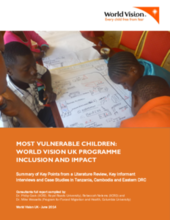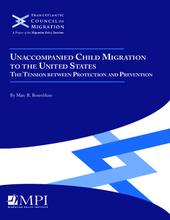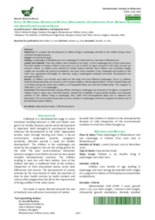Displaying 321 - 330 of 505
This report uses 80 surveys conducted by The Demographic and Health Surveys Program (DHS) and 55 Multiple Indicator Cluster Surveys (MICS), between 2000 and 2014 in 70 different countries, to estimate the prevalence of the components and combinations of vulnerability.
In this executive summary, the Truth and Reconciliation Commission of Canada provides an introduction to the use of residential schools for aboriginal children in Canada, presents an overview of the Commission’s activities, describes the history and legacy of these residential schools, and outlines the challenges of reconciliation, including 94 recommendations, or “calls to action” for reconciliation in the field of Child Welfare among many others.
The purpose of the research highlighted in this report was to assess and analyze the extent to which World Vision UK is reaching ‘the most poor and marginalised’ or Most Vulnerable Children (MVC) through its Child Protection programming in Cambodia, Tanzania, and Eastern DRC.
Using empirical data and interviews with orphans in Jordan, this article investigates how they experience the patriarchy of law, society, and the state.
This report examines the policy challenge in the United States of balancing protection and immigration enforcement in the recent unaccompanied child migration “crisis” in the US.
In this article, the author, David Graham, draws comparisons between the experiences and needs of youth transitioning out of care in the UK and those of individuals who are formerly incarcerated reintegrating into society.
This study examines the relationship between foster care placement as a predictor of adult substance use disorders (including frequency, severity and type), mental illness, vocational functioning, service use and duration of homelessness among a sample of homeless adults with mental illness.
In this article, the author addresses the topic of child neglect, or allegations thereof, as it relates to children and families in the Child Welfare System in the United States.
The present study employed Interpretative Phenomenological Analysis (IPA) to explore the experiences and meaning of motherhood among teen mothers in foster care in the United States.
This study compares the development of children living in orphanages with that of children living in slums with their biological parents in Odisha, India.




